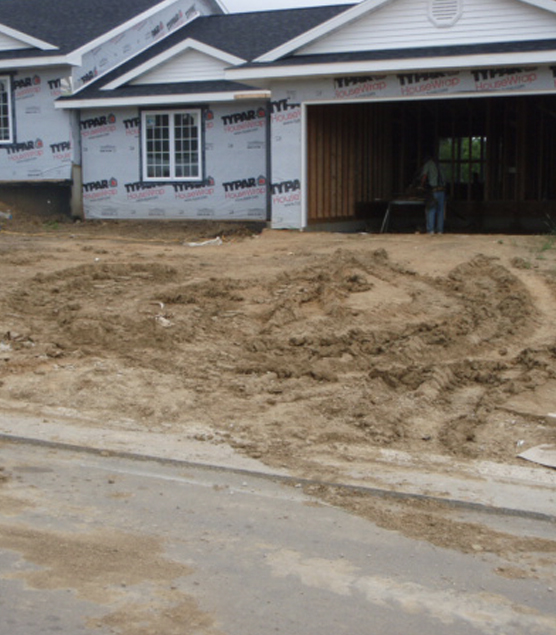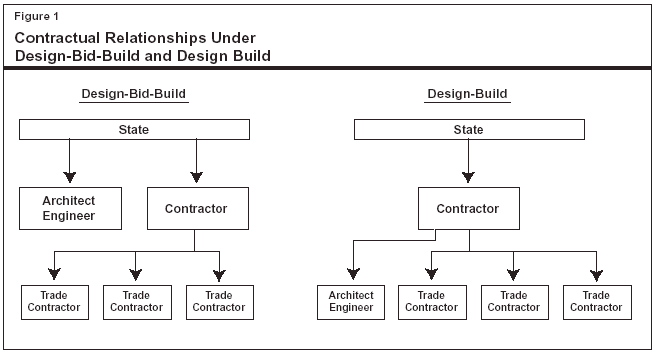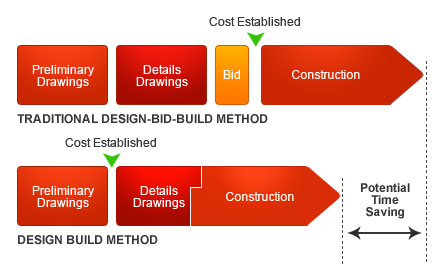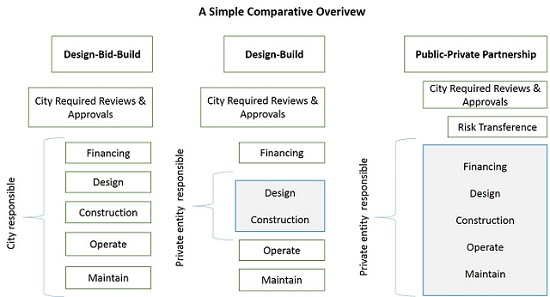MS4 permits require communities to regulate both new and redeveloped private developments. Therefore, your municipal stormwater program may require private landowners and builders to construct structural stormwater controls (such as detention/retention ponds or green infrastructure) as part of their projects to prevent adverse effects on public infrastructure and local waterbodies. Beyond MS4 permit compliance, though, there are additional benefits you can achieve by involving private parties in municipal stormwater management.
Benefits of engaging with private parties
Beyond complying with MS4 permits, communities should consider engaging private parties in stormwater management because they can:
- Provide a comprehensive approach to stormwater management. Polluted stormwater is a major cause of water quality impairments in urban areas, and most land from which stormwater flows is privately owned. It should come as no surprise, then, that communities are looking for ways to engage private properties to reduce these impacts by implementing stormwater controls. In addition, private properties might not have existing utility infrastructure and other site constraints, which makes them potentially low-cost siting locations for green infrastructure or other stormwater management investments.
- Provide alternative project funding and delivery options that improve cost-effectiveness, risk allocation, timeliness, and environmental outcomes. Stormwater infrastructure projects have traditionally followed the familiar design-bid-build paradigm, and they have tended to be completely public-led or completely private—not a mix. However, there is increasing interest in applying non-traditional approaches to deliver infrastructure projects more quickly and at lower cost. Non-traditional approaches integrate two or more services associated with project design, build, finance, operation, and maintenance. They can lower costs, reduce project delivery schedules, reduce public agency risks, and enable the use of a mix of public or private financing tools. In some instances, these frameworks take the form of a public-private partnership (P3); in other instances, they may take the form of a performance-based contract.
- Unlock the potential for innovative partnerships. Unlike some other infrastructure sectors, stormwater infrastructure affects many stakeholders across a variety of sectors. While we all rely on wastewater treatment technologies in daily life, a treatment plant’s footprint has limited physical impacts on a community and its stakeholders. In contrast, many types of landscapes can create stormwater runoff, and the infrastructure to manage this runoff may need to be distributed across a wide range of properties. Stormwater considerations can be part of projects implemented by many departments—such as public works, parks, roads, and economic development. Therefore, P3s and partnerships between two or more public agencies can provide opportunities for cost savings and enhance the overall project value based on shared interests and goals. See Integrating Stormwater with Other Public Programs and Projects for more ideas about potential partners and partnerships.

Photo of a partially constructed single family home. Dirt has been tracked from the home lot into the roadway.
Economic instruments for private property stormwater investments
Market-based economic instruments such as incentive programs can offer a powerful motivation for private landowners to incorporate stormwater infrastructure projects (e.g., retrofits, redevelopment, and new development) on various property types, including residential, commercial, and institutional properties. Private landowners and investors can become more involved in addressing stormwater management challenges through the following types of programs:
-
- Incentive-based programs: These programs are designed to change behavior using incentives such as cost avoidance, financial gain, and program/project support.
Cost avoidance programs include:- Fee reductions: Reduced stormwater fees for those who implement and maintain a stormwater asset on private property.
- Insurance premiums: Reduced flood insurance premiums for those who adopt specified stormwater management practices.
- Basic subsidy: The public pays for a portion (or all) of a stormwater investment on a private parcel. This may require cost-sharing with property owners.
- Enhanced subsidy: A public entity establishes a program or framework that provides payments to private firms or property owners that design, implement, and inspect and maintain stormwater infrastructure.
- Land developer support: Those who integrate specific types of stormwater management infrastructure into a project may be eligible for a reduced review fee or review time.
- Offsite stormwater management and credit-based programs: Some communities may have onsite retention or treatment requirements for new development and redevelopment. Where allowed, offsite stormwater management and credit-based programs can provide flexibility for new development and redevelopment sites to comply with local requirements by allowing them to manage stormwater at an alternative location, usually within the same watershed. These programs provide overall water quality and quantity benefits in cases where site constraints or other circumstances might not allow requirements to be met on the regulated site.
Communities have developed different types of programs to provide flexibility to accommodate stormwater management investments. These programs can reduce costs through market forces and expand overall opportunities for implementation of stormwater management infrastructure. They include:- Developer-led programs: Developers, rather than a public entity, identify a site or sites where investments can be made to offset post-construction stormwater impacts at a regulated site or project.
- In-lieu fee programs: Developers pay a fee in lieu of making onsite green stormwater investments. The funds are used to pay capital and operation and maintenance costs for stormwater management investments.
- Municipal stormwater credit programs: These programs can provide an alternative approach for meeting a post-construction performance standard for new development and redevelopment in an MS4 or construction stormwater permit or a state regulation. A credit-based approach commoditizes aspects of stormwater management treatment, such as stormwater volume, and facilitates the selling/buying of stormwater volume credits on a transactional platform or through bilateral negotiation. The program is based upon a measurable metric (e.g., gallons of runoff retained, acres of impervious cover treated). The credits in this context are exchanged within a single jurisdiction that holds the NDPES MS4 permit.
- Regional stormwater credit programs: A public entity or an established authority (e.g., Watershed Improvement District) in key areas makes regional investments. The “credits” of excess stormwater treatment that are generated are then “sold” to private parties (developers) or retired to meet public regulatory requirementss.
- Incentive-based programs: These programs are designed to change behavior using incentives such as cost avoidance, financial gain, and program/project support.
Case Study: King County, Washington
Craft3 is a nonprofit that provides opportunities for rebate advances for green infrastructure. These rebate advances help low-income residents who would otherwise lack the capital to implement green infrastructure practices on their properties, helping to promote equity in green infrastructure investments. Incentive-based programs such as this use financial opportunity to encourage the development of green infrastructure in private projects, which brings benefits to the community at large by conserving drainage infrastructure capacity.
EPA recently issued a memo regarding water quality trading and market-based approaches.
Alternative project delivery approaches
The traditional way of implementing stormwater infrastructure in the United States is through the design-bid-build process. This model provides a fair and deliberate way to deliver projects but has built-in inefficiencies that reduce the pace of project construction. A movement to consider alternative project delivery approaches has emerged as the need to improve and expand the nation’s aging infrastructure has increased. These alternative approaches could provide platforms for public and private financing, as well as opportunities for the public, private, and nonprofit sectors to unlock efficiencies through opportunistic and win-win arrangements, which may include revenue, funding, and financing aspects. Below are five examples of alternative project delivery approaches:
- Design-build: By shortening the bidding process and reducing the frictional costs associated with the bidding phase, the design-build approach reduces overall project delivery timeframes and costs. Project outcomes are aligned with both design and construction service providers, making designers more invested in project construction and implementation. Finally, the design-build approach requires the private sector to lead project delivery and be accountable for these services in a performance-based manner, thus reducing risks to the public sector.
- Design-build-plus: Like the design-build method, the design-build-plus approach delivers cost savings and a quicker project delivery timeframe. However, it could potentially produce even greater savings and shorter timeframes by integrating additional services. This approach includes a financing option, which can reduce the public sector’s debt obligation and financial risk profile, as well as open options for communities that have a poor debt rating or are otherwise limited in their public financing capacity. The design-build-plus method can include unique arrangements to phase in the private sector, including the following models:
- Construction manager at-risk: Under this model, the public sector has a high level of control and develops the design plans. A private party (i.e., the construction manager) advises during the design phase, becoming familiar with the project and acting as an advocate for the owner. The private party also agrees to construct the project at a guaranteed maximum price, which reduces the public sector’s risk on the construction side.
- Build-operate-transfer: Under this model, the private partner owns the asset and leases it to a public entity for a period of time, then transfers it back to the public sector.
- Build-own-operate: Under this model, the private partner owns the asset and does not transfer it back to the public sector.\
- Full-delivery model: Also known as the “turn-key” or “design-build-operate-maintain” project delivery model, this model empowers the private sector to identify and site projects. The private sector also takes on all project financing and project delivery risks. Advantages include eliminating risks for the public sector, reducing project delivery costs, and increasing the number of implemented projects.
Case Study: Anne Arundel County, Maryland
Anne Arundel County, Maryland, launched a first-of-its-kind contract system for implementing stormwater projects in order to comply with federal permits. The County’s $3.8 million “full delivery of water quality improvements” contract was competed via a bidding process, and payment to the winning firm will be made upon successful project completion. This system enables the County to maintain oversight while catalyzing markets to do what they do best, including finding innovation and cost efficiencies.
The winning team will be reimbursed only after conditions are met. See a video interview of Erik Michelsen with Anne Arundel County, Maryland.
4. Community-based public-private partnership (CBP3): A CBP3 contains several formal elements of a typical P3, including integrated project delivery services, the potential for private and blended financing, and fixed fees. In addition, CBP3s have the following characteristics:
-
- A public agency retains a self-defined amount of control over the program.
- Community goals and interests are central to the program.
- Additional profits gained through cost efficiencies in project delivery are automatically reinvested into the program.
- Either public or private financing can be used—whichever is best for the community in a particular case.
Case Study: Prince George’s County, Maryland
In March 2015, Prince George’s County established a CBP3 entity, the Clean Water Partnership, to focus on integrated green stormwater infrastructure. The Partnership identified 2,000 impervious acres for initial the 3-year “pilot” phase, which completed in June 2018. Using the traditional project delivery approach, to total cost to retrofit 2,000 impervious acres would have been ~$300 million. Instead, using the County’s CBP3 approach, the projected cost was ~$100 million, and ended up costing only $92 million (unit cost ended up being $44,000/impervious acre). Additionally, the County was able to reduce the project delivery time by more than 50 percent.
- Cooperative partnerships: Communities often arrange for multiple parties to invest in infrastructure to leverage the strengths of each sector involved with a project or program’s specific challenges. This is known as a cooperative partnership. These partnerships can face challenges, such as complexities in and barriers to public procurement, as well as the need to raise capital for an infrastructure project. However, cooperative partnerships can help significantly reduce costs for stormwater management infrastructure by taking advantage of synergies when multiple projects can be coordinated or combined. For example, the cost to retrofit a roadway to integrate green infrastructure into the landscape is higher if done as a standalone project. Conversely, if a road is already being rehabilitated or reconstructed, the marginal cost for implementing green infrastructure is much lower, as it is an ancillary part of the larger construction effort.

Contractual Relationships Under Design-Bid-Build and Design Build

Traditional Design-Bid Build Method Timeline vs. Design Build Method Timeline

Comparative Overview of Alternative Project Delivery Methods
Resources
See Developing and Administering a Dedicated Revenue Source and the following additional resources for more guidance on economic opportunities for engaging with the private sector and property owners.
| Article Description | Categories | categories_hfilter |
|---|---|---|
Memo on “Updating the EPA’s Water Quality Trading Policy to Promote Market-Based Mechanisms for Improving Water Quality”Author: U.S. EPA | Developed/Updated on Date: February, 2019 Web Link: https://www.epa.gov/sites/production/files/2019-02/documents/trading-policy-memo-2019.pdf Purposes of this memorandum: | Funding: Private Sector Opportunities, Water Quality Outcomes: Watershed-Based Models | private-sector-opportunities watershed-based-models |
Land Conservation Loans: Rebate Advances to RainWise ContractorsAuthor: Craft3 | Developed/Updated on Date: 2019 Web Link: https://www.craft3.org/Borrow/conservation-loans/rainwise-pilot-access-loan-program Craft3 provides pre-construction rebate advances to RainWise Contractors for green infrastructure projects with pre-approved Seattle Public Utilities (SPU) or King County rebates. This program expands access to the RainWise program by enabling contractors to work with clients who cannot pay upfront for the work. | Funding: Private Sector Opportunities | private-sector-opportunities |
Financing Green Infrastructure—Is a Community-Based Public-Private Partnership (CBP3) Right for You?Author: U.S. EPA | Developed/Updated on Date: June 18, 2019 Throughout the United States, communities are struggling to meet the demands of stormwater management requirements. EPA recognizes the need for new and innovative solutions to finance and manage stormwater runoff, especially in urban areas, to achieve and maintain the water quality goals of the Clean Water Act. In order to protect and restore water quality while meeting the challenges of climate adaptation, communities should consider whether a community-based public-private partnership (CBP3) will help achieve their goals when evaluating stormwater financing and infrastructure needs. | Funding: Private Sector Opportunities, Public Education and Outreach, Public Participation | private-sector-opportunities public-education-and-outreach public-participation |
Community-Based Public-Private Partnerships (CBP3s) and Alternative Market-Based Tools for Integrated Green Stormwater InfrastructureAuthor: U.S. EPA | Developed/Updated on Date: April 2015 Public-private partnerships (P3s) have the potential to help many communities optimize their limited resources through agreements with private parties to help build and maintain their public infrastructure. P3s have successfully designed, built, and maintained many types of public infrastructure, such as roads and drinking water/wastewater utilities across the United States. Until recently, there have been no P3s specifically developed for stormwater management or Clean Water Act requirements. The U.S. Environmental Protection Agency (EPA) Region 3 Water Protection Division (WPD) has been researching, benchmarking, and evaluating P3s for their potential adaptation and use in the Chesapeake Bay region. On December 6, 2012, the EPA Region 3 WPD hosted a P3 Experts Roundtable in Philadelphia, Pennsylvania (U.S. EPA, 2013a). The goal of the P3 roundtable was to provide a forum for a targeted group of private-sector representatives to discuss in detail the feasibility, practicality, and benefits of using P3s to assist jurisdictions in the finance, design, construction, and operation and maintenance of an urban stormwater retrofit program. The results of this roundtable are the foundation and approach for applying a stormwater P3 model across the Chesapeake Bay watershed. This guide provides communities with an opportunity to review the capacity and potential to develop a P3 program to help “close the gap” between current resources and the funding that will be required to meet stormwater regulatory commitments and community stormwater management needs. In addition, this guide and the tools presented are a continuing effort, commitment, and partnership between EPA Region 3 and communities in the Chesapeake Bay region. The authors of the guide believe it will help to raise the bar and further advance the restoration goals and objectives for the Chesapeake Bay. | Funding: Dedicated Revenue Source, Funding: Private Sector Opportunities | dedicated-revenue-source private-sector-opportunities |
“Full Delivery” Contract ModelAuthor: MOST Center | Developed/Updated on Date: 2017 Web Link: https://youtu.be/zrpQnBPi6MI Anne Arundel County, Maryland, launched a first-of-its-kind contract system for implementing stormwater projects in order to comply with federal permits. The County’s $3.8 million “full delivery of water quality improvements” contract was competed via a bidding process, and payment to the winning firm will be made upon successful project completion. This system enables the County to maintain oversight while catalyzing markets to find innovation and cost efficiencies. Erik Michelsen, Administrator of the County’s Watershed Protection and Restoration Program, describes how this system benefits both the government and the private contractor, the learning curve for public procurement and regulatory departments, and the potential for stormwater to mimic the mitigation banking model in which restoration practices are put into place before impact occurs. | Funding: Private Sector Opportunities, Management of Post-Construction Site Runoff | private-sector-opportunities management-of-post-construction-site-runoff |
Program Structure Article 01Author: Uki Dele, P.E | Developed/Updated on Date: 2017 Web Link: https://www.stormcon.com/wp-content/uploads/2017/08/Dele_P62.pdf Asset Management (AM) for Stormwater Systems is becoming increasingly essential in managing assets for achieving water quality objectives while continuing to provide flood protection. Asset Management is a structured approach to optimizing the life-cycle cost of asset ownership and focuses on providing reliable and dependable service to customers. Read More | Funding: Private Sector Opportunities | private-sector-opportunities |

